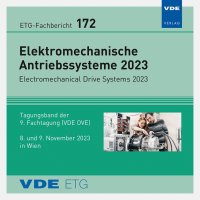Thickness of aluminum-oxide layer in insulated bearings to reduce circular bearing currents in a 110 kW induction machine
Konferenz: Elektromechanische Antriebssysteme 2023 - 9. Fachtagung (VDE OVE)
08.11.2023-09.11.2023 in Wien, Österreich
Tagungsband: ETG-Fb. 172: Antriebssysteme 2023
Seiten: 7Sprache: EnglischTyp: PDF
Autoren:
Safdarzadeh, Omid; Binder, Andreas (Technical University of Darmstadt, Germany)
Inhalt:
Parasitic common-mode (CM) electric currents are produced in electrical motors by the CM voltage of the feeding voltage-source inverters. They increase with the high du/dt of the three phase-to-ground voltages, which constitute the CM voltage on the motor terminals. At high motor speed, the lubricated ball bearing behaves like a resistive-capacitive impedance, depending on the type of lubricant. A part of the CM current passes through the bearings, either as a capacitive current, discharge current or ohmic current. In high power machines above 50 kW, an additional HF circular differential-mode (DM) bearing current is caused by the magnetic HF CM flux, which is excited by the CM current. At low speeds from 0 rpm to 300 rpm, when the lubrication film in the bearing is thin and partially bridged, the circular bearing currents have increased amplitudes, and can wear the bearing surface gradually e.g. via fluting, leading to a bearing failure. One measure against the unwanted DM circular bearing current at low speed and CM bearing currents at elevated speed is using insulated bearings. They have an aluminium oxide (Al2O3) layer on the outer ring, insulating electrically the outer ring from the bearing seat. The required aluminium-oxide thickness is investigated to reduce the circular bearing currents to the safe values of an apparent bearing current density below 0.1 A/mm2 with ball bearings in a 110 kW 4-pole cage-induction motor. Two thickness values of aluminium-oxide, 120 µm and 500 µm, are investigated and the results are compared with the case where conventional steel bearings, type 6316 and 6317, are used. Moreover, hybrid bearings with ceramic rolling elements are tested and compared, yielding a stronger suppressing effect of the bearing currents.


